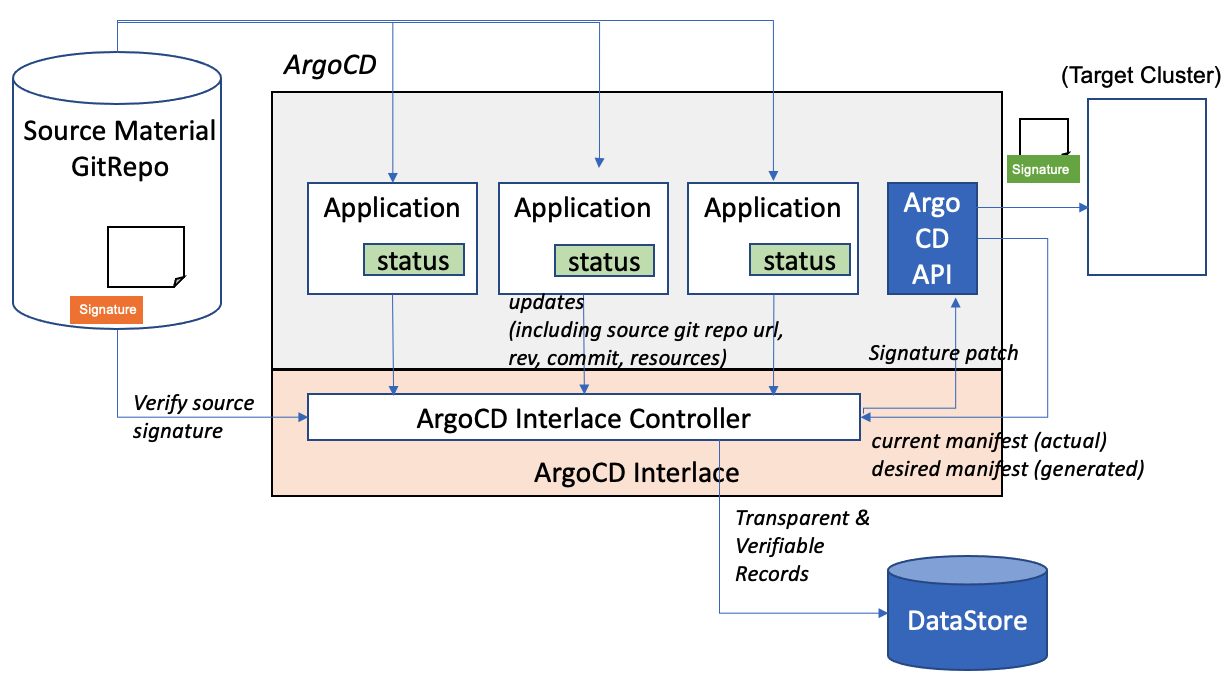ArgoCD is widely used for enabling CD GitOps. ArgoCD internally builds manifest from source data in Git repository, and auto-sync it with target clusters.
ArgoCD Interlace enhances ArgoCD capability from end-to-end software supply chain security viewpoint. Interlace adds authenticity of the manifest and the traceability to the source to ArgoCD.
ArgoCD Interlace works as a Kubernetes Custom Resource Definition (CRD) controller. Interlace monitors the trigger from state changes of Application resources on the ArgoCD cluster. When detecting new manifest build, Interlace sign the manifest, record the detail of manifest build such as the source files for the build, the command to produce the manifest for reproducibility. Interlace stores those details as provenance records in in-toto format and upload it to Sigstore log for verification.
The features are
- Pluggable to ArgoCD
- Verify signature of source materials used for generating manifest
- Capture manifest and provenance from application.status automatically
- Sign manifest
- Record provenance in in-toto format
Prerequisite: Install ArgoCD on your Kubernetes cluster before you install ArgoCD Interlace.
To install ArgoCD Interlace, run:
$ kubectl apply -f https://raw.githubusercontent.com/argoproj-labs/argocd-interlace/main/releases/release.yaml
On OpenShift, use this instead of the above.
$ kubectl apply -f https://raw.githubusercontent.com/argoproj-labs/argocd-interlace/main/releases/release_openshift.yaml
Then you can check whether ArgoCD Interlace is running just by looking at the pod status.
$ kubectl get pod -n argocd-interlace
NAME READY STATUS RESTARTS AGE
argocd-interlace-controller-5b6cd5f896-vwtrj 1/1 Running 0 2m
By default, ArgoCD Interlace stores the generated provenance record in a custom resource ApplicationProvenance in argocd-interlace namespace.
When ArgoCD syncs any Applications, ArgoCD Interlace creates the ApplicationProvenance and you can see the provenance data as below.
$ kubectl get appprov -n argocd-interlace
NAME AGE
sample-app 3m40s
$ kubectl get appprov -n argocd-interlace sample-app -o json
{
"apiVersion": "interlace.argocd.dev/v1beta1",
"kind": "ApplicationProvenance",
"metadata": {
"creationTimestamp": "2022-06-15T00:33:07Z",
"generation": 1,
"name": "sample-app",
"namespace": "argocd-interlace",
"resourceVersion": "1553595",
"uid": "bc081b63-0595-4917-9a0e-2869a7dd1eeb"
},
"spec": {
"application": {
"name": "sample-app",
"namespace": "argocd"
}
},
"status": {
"lastUpdated": "2022-06-15T07:04:05Z",
"results": [
{
"manifest": "ICBh ... ODAK", // base64 encoded resource manifest
"provenance": "eyJf ... fQ==", // base64 encoded provenance data
"sourceVerified": false, // whether source material was verified or not
"time": "2022-06-15T07:04:05Z" // timestamp of the update
}
]
}
}
In the spec field, you can find which Application was the target of this provenance data.
In the status field, you can find the generated manifest for the Application sync and the provenance data generated by ArgoCD Interlace. (These two values are encoded in base64.)
For more details about the provenance data, you can refer this doc
ArgoCD Interlace supports 3 other features other than provenance recording.
1. Verify source material contents before generating provenance
Before ArgoCD Interlace generates provenance data, it can verify the source metrial contents. For that, you can sign the source meterials (Git Repo / Helm) beforehand (see the doc). This allows you to confirm that the source contents of the synced application is valid by verifying the signature.
You can enable this feature by configuring the secret source-material-verify-key in argocd-interlace namespace.
You can do it by the following command. <PATH/TO/PUBLIC_KEY> should be the actual filepath (refer this about key setup).
$ KEY_PATH=<PATH/TO/PUBLIC_KEY> kubectl patch secret source-material-verify-key -n argocd-interlace -p="{\"data\":{\"public_key_pem\":\""(cat $KEY_PATH | base64)"\"}}"
Note that it takes about a minute that the key in the running pod is updated after this command.
With this feature, sourceVerified field in the ApplicationProvenance status will be true if the verification successfully finishes.
2. Sign the generated provenance data
By default, ArgoCD Interlace just generates a provenance data and the data is not authorized. You can enable signing feature for the generated provenance data so that the provenance data can be verified when it is used somewhere other than ArgoCD / ArgoCD Interlace.
By configuring the secret interlace-signing-key in argocd-interlace namespace, you can enable this.
You can do it by the following command. <PATH/TO/PRIVATE_KEY> should be the actual filepath (refer this about key setup).
$ KEY_PATH=<PATH/TO/PRIVATE_KEY> kubectl patch secret interlace-signing-key -n argocd-interlace -p="{\"data\":{\"private_key_pem\":\""(cat $KEY_PATH | base64)"\"}}"
Note that it takes about a minute that the key in the running pod is updated after this command.
With this feature, signature field is added to the status in ApplciationProvenance and it contains the generated signature.
3. Sign the manifest generated by ArgoCD
Additionally, you can enable signing feature for the YAML manifest geneated by ArgoCD. For this, ArgoCD Interlace leverages the manifest signing feature provided by sigstore community (k8s-manifest-sigstore).
To enable this, you can add a ConfigMap resource with a label signatureResource: true to your source material repository.
When this ConfigMap is found in the synced resources, ArgoCD Interlace signs the YAML manifest and the signature will be stored in the ConfigMap on the cluster.
This feature requires the 2 secrets configured by the above steps.
To see ArgoCD Interlace in action, check the example scenario.

